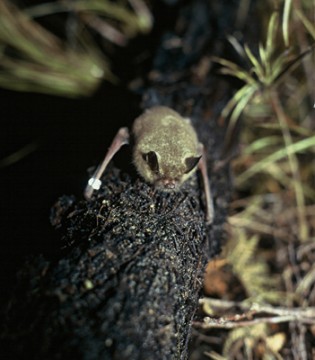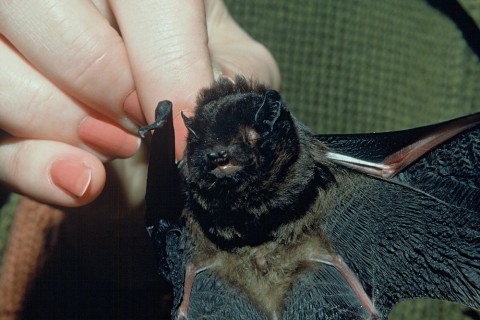Diary of a bat hunter
Forest & Bird’s Bat Survey Officer, Top of the South, Brian Lloyd
Tasked with the job of surveying bat populations in the top of the South island, I have spent many summer days setting out bat detectors around the countryside in the hope that they pick up the high frequency echolocation (or clicks) that bats use to navigate their way around.

Short-tailed bat, Photo: Rosalind Cole
Sometimes a seemingly fruitless task , finding populations of these rare and elusive short-tailed and long-tailed bats, contributes to a national picture of the status of these two disappearing species.
Differing not only in appearance, but also with respect to feeding patterns & behaviour, our two bat species share little in common.
Short –tailed bats generally roost in large tree cavities, and in winter are known to stay in their roosts and go into torpor. Like our kakapo, they have a lek breeding system, which is the equivalent of a male sing-star contest to win over a prize mate. Most peculiarly though, is the way that they forage. Unlike most other micro-bats that catch air-borne creatures, short-tailed bats are known to forage on the ground using their folded wings as front limbs. This unusual trait makes them particularly vulnerable to predation. In the central North Island I found several thousand of these wonderful creatures in the large tracts of indigenous forest from Urewera west to Taranaki. A career highlight!

Long tailed bat, photo courtesy of DOC
Long-tailed bats in contrast, are smaller, catch air-borne prey and have been known to fly up to 60kms an hour. Looking back one hundred years, these bats were common and widespread throughout the region. In the last 50 years, populations have plummeted and bats are now uncommon and rarely encountered, except for the West Coast – and that’s another story. Habitat destruction has lead to much of the population decline, but there is still much we don’t know. Any populations left in the Nelson, Marlborough are most likely to be long-tailed bats. Few short-tailed bat sightings have been noted over the last 100 years.
So far, I’ve found two significant populations of long-tailed bats remaining in the area. One is near the Golden Bay end of the Heaphy Track, and the other is in the much more accessible Pelorus Bridge Scenic Reserve, on the State Highway between Blenheim and Nelson. We’re now in the process of seeking more funding from external sources to monitor these populations, including looking at things like the impact of rodents and stoats.
In November we had a bat monitoring workshop at Pelorus Bridge Scenic Reserve. More than twenty keen Forest & Bird members learnt how to use automatic bat detectors. It was a great weekend, with bats gracing us with their presence over two evenings. Schooled in bat detection, two Forest & Bird volunteers, Julie McLintock and Pam McConnell, began surveying Whangamoa, Rai Valley and the Marlborough Sounds, and since then have discovered populations in the Rai valley!
Ultimately our work with these bat populations, will contribute at a national level to the goals of the Department of Conservation’s Bat Recovery Plan. With bats listed as “nationally endangered”, our work with these land mammals is an important issue for conservation. Let’s just hope, some short-tailed bats come out of the wood-work!

